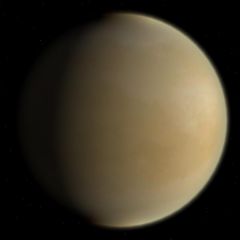Venus
Venus is the second planet from the Sun. It has a day longer than a year. The year length of Venus is 225 Earth days. The day length of Venus is 243 Earth days. It is a terrestrial planet because it has a solid, rocky surface like other planets in the inner solar system. Astronomers have known Venus for thousands of years. The ancient Romans named it after their goddess Venus. Venus is the brightest thing in the night sky except for the Moon. It is sometimes called the morning star or the evening star as at some elongations it is easily seen just before the sun comes up in the morning and, at other elongations, just after the sun goes down in the evening. Venus comes closer to the Earth than any other planet does.
Venus is sometimes called the sister planet of Earth as they are quite similar in size and gravity. In other ways, the planets are very different. Venus' atmosphere (air) is mostly carbon dioxide with clouds of sulphuric acid. Sulphuric acid is a chemical that is very poisonous to humans.
The thick atmosphere has made it hard to see the surface, and until the twenty-first century, many people thought things might live there. The pressure on Venus' surface is 92 times that of Earth. Venus has no moons. Venus spins very slowly on its axis and it spins in the opposite direction to the other planets.
Surface features
Although Venus is modeled as a sphere, there are more than 2000 surface features marked on Venus and are labeled if the labels are turned on in the Display menu.
See List of surface features on Venus
Missions to Venus available as add-ons
- Mariner 2 at Orbit Hangar
- Mariner 10 by missleman01 at Orbit Hangar
- Mariner 10 for Orbiter 2010 by felipi1205 at Orbit Hangar
- STS-30 (Atlantis) and Magellan by Gargantua2024 at Orbit Hangar
- Venus Express by martyspacelines at Orbit Hangar
- Messenger by Ëåäíåff at Orbit Hangar
- GEP - Messenger by thexfiles19 at Orbit Hangar
- Venera 9 by 4th rock at Orbit Hangar
- Vega1 & Vega2 by brianj at Orbit Hangar
- Venera-D by kodiak at Orbit Hangar
Historical missions to Venus
For a complete list of historical missions, see Missions to Venus.
Flight Warning!
At the surface of Venus, the atmospheric pressure is 9.2MPa, over 90 atmospheres. This is substantially greater than the back-pressure which standard rocket motors are able to generate; a Delta-glider landed on Venus will not be able to take off (at least if the complex flight model is in use).
See Also
- Venus at Wikipedia.
- Go to Addons for Venus
| edit The Solar System | |
|---|---|
| Central star |
Sun (Sol) |
| Planets |
Mercury - Venus - Earth - Mars - Jupiter - Saturn - Uranus - Neptune |
| Natural satellites |
Moon - Phobos - Deimos - Io - Europa - Ganymede - Titan - more... |
| Add-ons |
Planets - Dwarf Planets - Small objects - Natural satellites - Alternative star systems |
 | This article, about a planet, is a stub. You can help Orbiterwiki by expanding it. |
